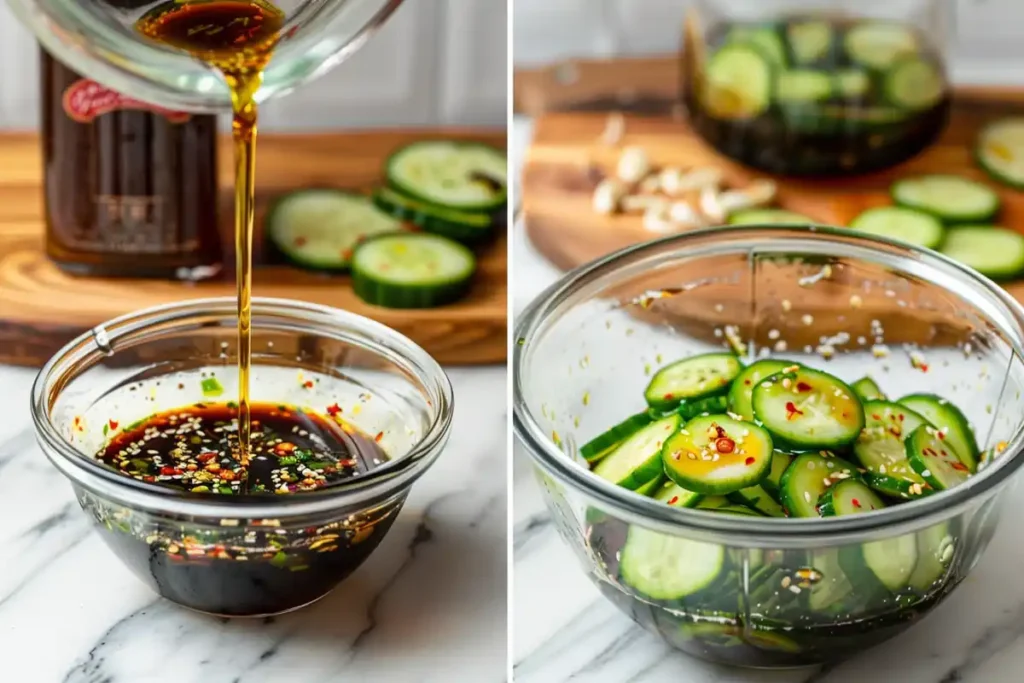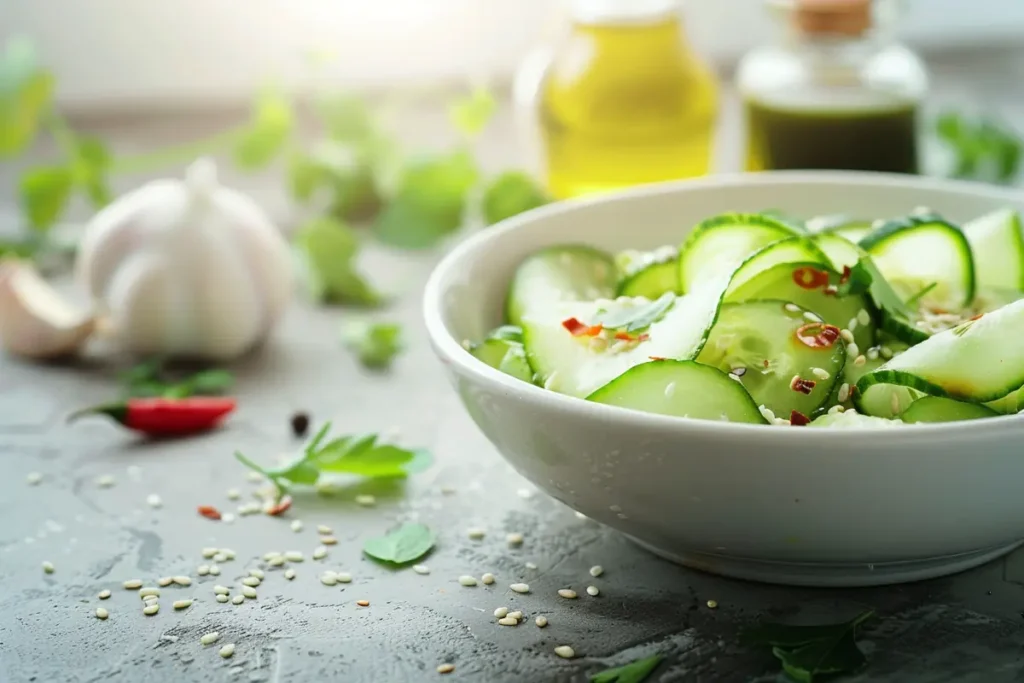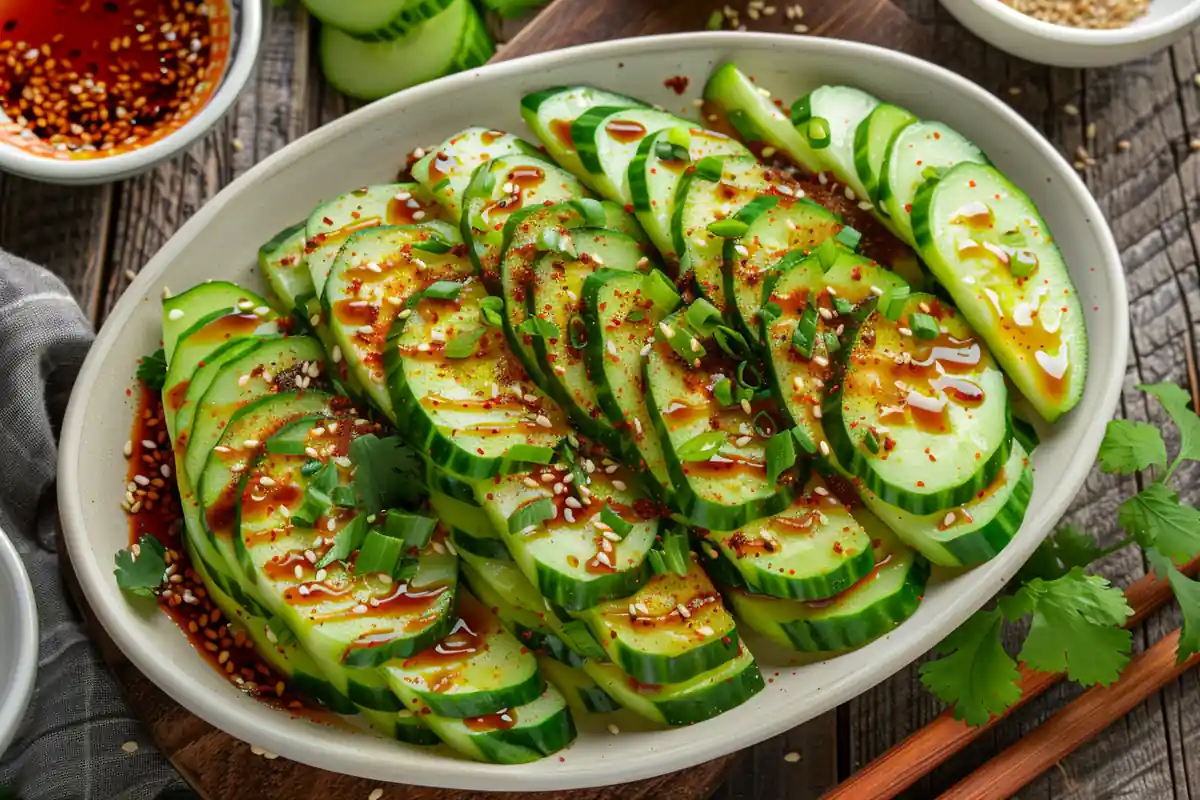Din Tai Fung cucumber salad is more than just a side dish; it’s a harmonious blend of crisp, refreshing textures and bold flavors. Inspired by traditional Taiwanese cuisine, this appetizer has captivated food enthusiasts worldwide. Whether you’ve savored it at Din Tai Fung or are looking to recreate it at home, this article will guide you through every detail—from its unique flavor profile to a step-by-step recipe.
Discover what makes this dish stand out, its health benefits, and cultural significance. Plus, get practical tips for perfecting it in your own kitchen. Let’s dive into the world of Din Tai Fung cucumber salad!
1: Introduction to Din Tai Fung Cucumber Salad
What is Din Tai Fung Cucumber Salad?
Din Tai Fung cucumber salad is a simple yet flavor-packed dish crafted from marinated cucumbers bathed in a tangy, spicy, and slightly sweet dressing. This appetizer is an iconic part of Din Tai Fung’s menu, offering a refreshing counterpoint to their rich and savory dumplings. With its balance of soy sauce, chili oil, and rice vinegar, it’s a dish that perfectly encapsulates Asian-inspired culinary excellence.
Why It’s a Beloved Dish Among Din Tai Fung Fans
Why is this salad so loved? It’s all about balance! The combination of fresh, crunchy cucumbers and the bold, umami-packed dressing creates a dish that’s light yet flavorful. Fans adore its simplicity, versatility, and how it tantalizes the taste buds without overwhelming them. Whether you’re enjoying a full-course meal or seeking a snack, this dish never disappoints.
The Popularity of Asian-Inspired Cucumber Salads
Cucumber salads are a staple in many Asian cuisines, from Korean oi muchim to Japanese sunomono. Each version boasts its own unique twist, but they all share a commitment to fresh, vibrant flavors. Din Tai Fung’s rendition stands out for its masterful use of spices and premium ingredients. This dish has become a gateway for many diners to appreciate the broader culinary traditions of Taiwan and beyond.
2: The Flavor Profile of Din Tai Fung Cucumber Salad
The Balance of Sweet, Tangy, and Spicy Notes
What sets the Din Tai Fung cucumber salad apart is its perfect balance of flavors. The combination of sweetness, derived from a touch of sugar, and the tanginess of rice vinegar creates a refreshing base. Add a spicy kick from chili oil, and you’ve got a dish that wakes up the palate. These layers of taste make the salad both simple and sophisticated—a hallmark of Taiwanese cuisine.
Key Ingredients that Define the Dish
The beauty of this salad lies in its simplicity and the use of premium ingredients. Key components include:
- Soy Sauce: Adds depth and a savory note.
- Rice Vinegar: Provides a mild tanginess that doesn’t overpower.
- Sesame Oil: Contributes a nutty aroma and silky texture.
- Garlic: Offers a bold, pungent flavor.
- Chili Oil: Infuses heat and vibrant color.
The cucumbers themselves play a starring role, delivering a crunchy and hydrating element to balance the bold flavors of the dressing.
How Chili Oil Adds Depth and Heat
Chili oil is a must-have ingredient in this dish. It’s not just about spiciness—it also adds richness and complexity to the salad. A well-crafted chili oil, often featuring aromatics like Fresno chilis, sesame seeds, and star anise, elevates the dish to another level. It’s this ingredient that gives the Din Tai Fung cucumber salad its signature warmth and allure.
3: How to Make Din Tai Fung Cucumber Salad at Home
Step-by-Step Recipe Guide
Craving the authentic taste of Din Tai Fung cucumber salad at home? Follow this simple recipe to recreate the magic.
Ingredients Needed
- Persian or English cucumbers
- Soy sauce
- Rice vinegar
- Sesame oil
- Chili oil
- Garlic cloves
- Sugar
- Salt
Preparation of Cucumbers: Salting and Marinating
Start by slicing the cucumbers into thick rounds or batons. Sprinkle them with salt and let them rest for 30 minutes. This process draws out excess moisture, leaving the cucumbers crisp and ready to soak up the flavorful dressing.
Making the Dressing: Tips for Balancing Flavors
In a small bowl, combine soy sauce, rice vinegar, sesame oil, chili oil, minced garlic, and sugar. Whisk until the sugar dissolves completely. Taste and adjust—if it’s too tangy, add a pinch of sugar; if it lacks spice, add a splash more chili oil.
Common Mistakes to Avoid When Preparing the Salad
- Skipping the Salting Step: This crucial step prevents the cucumbers from turning soggy.
- Overpowering the Salad with Garlic: While garlic is essential, too much can overwhelm the dish.
- Using the Wrong Type of Cucumber: Opt for seedless varieties for the best texture.
Variations and Customizations to Suit Your Taste
While the original recipe is a classic, there’s room to play with flavors. Add a drizzle of honey for extra sweetness, or toss in roasted peanuts for a crunchier bite. Want to boost the heat? Use chili flakes in addition to chili oil. The possibilities are endless!

4: The Cultural and Culinary Significance of Din Tai Fung
A Brief History of Din Tai Fung as a Global Brand
Din Tai Fung isn’t just a restaurant; it’s a culinary institution. Originating in Taiwan in the 1950s, it started as a simple cooking oil business before transforming into a globally recognized dumpling house. With a reputation for precision, quality, and attention to detail, Din Tai Fung has earned Michelin stars and countless fans worldwide. The Din Tai Fung cucumber salad embodies the brand’s ethos: combining tradition with innovation to create memorable dining experiences.
Signature Dishes Beyond the Cucumber Salad
While the Din Tai Fung cucumber salad is a standout, the restaurant is best known for its legendary xiao long bao (soup dumplings). These delicacies, with their thin wrappers and savory fillings, perfectly complement the light, tangy cucumber salad. Other must-try dishes include fried rice, sesame noodles, and steamed buns, all of which reflect the same meticulous craftsmanship.
Why Simple Side Dishes Like the Cucumber Salad Matter
Side dishes like the cucumber salad play a critical role in enhancing the dining experience at Din Tai Fung. They offer a refreshing counterpoint to richer main dishes, cleansing the palate and preparing you for the next bite. The cucumber salad is a testament to the idea that even the simplest dishes, when made with care and the right ingredients, can leave a lasting impression.
For more culinary inspiration, explore recipes like these vibrant appetizers and side dishes.
5: Tips for Serving Din Tai Fung Cucumber Salad
Best Pairings with Other Asian-Inspired Dishes
The Din Tai Fung cucumber salad shines as a versatile dish that pairs beautifully with a variety of Asian flavors. Serve it alongside spicy ramen, teriyaki chicken, or vegetable spring rolls for a balanced meal. The salad’s cool, crisp texture and tangy dressing make it a refreshing addition to both casual and formal dining settings.
How to Store and Maintain Freshness
Storing this salad properly ensures it retains its crunch and flavor. Keep it in an airtight container in the refrigerator for up to three days. For best results, store the dressing separately and toss it with the cucumbers just before serving. This prevents the cucumbers from becoming too soft or soggy.
Ideal Occasions to Serve This Dish
Whether you’re hosting a dinner party or preparing a quick snack, the Din Tai Fung cucumber salad fits the bill. Its simplicity and universal appeal make it suitable for everything from weekday meals to special celebrations. Need a healthy appetizer for a barbecue or potluck? This salad delivers a crowd-pleasing punch of flavor with minimal effort.
For more delicious recipes to complement your meals, check out our quick and easy sides.
6: Health Benefits of Din Tai Fung Cucumber Salad
Low-Calorie and Refreshing Properties of Cucumbers
Cucumbers are the unsung heroes of healthy eating, and the Din Tai Fung cucumber salad makes full use of their benefits. Packed with water and low in calories, cucumbers are naturally hydrating and help you feel refreshed. Their high water content also supports digestion, making this salad an excellent choice as a light appetizer or snack.
Benefits of Sesame Oil and Garlic
Sesame oil isn’t just flavorful—it’s a powerhouse of nutrients. Rich in healthy fats and antioxidants, it promotes heart health and gives the salad its silky texture. Meanwhile, garlic, a staple in this recipe, offers immune-boosting properties and helps lower inflammation. Together, these ingredients not only elevate the salad’s taste but also add nutritional value.
How Spices and Vinegar Boost Digestion
Chili oil and rice vinegar do more than enhance the flavor of the Din Tai Fung cucumber salad. Chili oil stimulates metabolism and adds a gentle kick, while vinegar aids digestion by balancing stomach acidity. These elements make this salad not just delicious but also a smart choice for supporting a healthy gut.
7: FAQs
Can You Make It Ahead of Time?
Absolutely! The Din Tai Fung cucumber salad is perfect for meal prep. You can prepare the cucumbers and dressing separately up to two days in advance. Combine them right before serving to keep the salad crisp and fresh.
What’s the Best Type of Cucumber for the Salad?
Opt for seedless varieties like Persian or English cucumbers. Their firm texture and mild flavor make them ideal for soaking up the dressing without becoming soggy.
Is It Possible to Adjust the Spice Level?
Yes! If you prefer a milder version, reduce the amount of chili oil or omit it entirely. For extra heat, add more chili oil or sprinkle in crushed chili flakes.
Can It Be Made Gluten-Free?
Easily! Use tamari or gluten-free soy sauce in place of regular soy sauce, and you’ve got a gluten-free version of this classic salad.
Can I Add Other Ingredients to the Salad?
Definitely! While the original Din Tai Fung cucumber salad is delicious as is, you can personalize it to your taste. Toss in thinly sliced red onions for a slightly sweet and sharp crunch, or garnish with chopped cilantro for a fresh, herbaceous twist. You could even sprinkle crushed peanuts or roasted sesame seeds for added texture.
8: Tips for Perfecting the Din Tai Fung Cucumber Salad Recipe
Choose the Right Cucumbers
The type of cucumber you use makes a big difference in the final texture and flavor of the Din Tai Fung cucumber salad. Persian or English cucumbers are ideal because they’re seedless, crisp, and have thin skins that don’t need peeling. If you’re using regular cucumbers, consider peeling and deseeding them for a smoother texture.
Master the Art of Marinating
Marination is key to achieving the authentic flavors of this dish. Salting the cucumbers beforehand helps draw out excess water, allowing them to soak up the dressing more effectively. Be patient—letting the cucumbers marinate for at least 15-30 minutes ensures the flavors meld beautifully.
Experiment with Ingredients
While the original recipe is a classic, it’s fun to experiment. Add crushed peanuts or sesame seeds for texture, or include thinly sliced chili peppers for a fresh pop of heat. You can also play with the balance of soy sauce and vinegar to suit your taste preferences.

9: Why Din Tai Fung Cucumber Salad is Perfect for Every Occasion
A Versatile Dish for Any Meal
The Din Tai Fung cucumber salad is a dish that fits seamlessly into various meals and occasions. Whether you’re hosting a casual dinner, preparing a festive feast, or packing a light picnic, this salad is an excellent choice. Its refreshing crunch and bold flavors make it a standout, whether served as a side dish or a light appetizer.
Loved by All Ages
This salad’s universal appeal is part of what makes it so special. Kids enjoy the mild sweetness and crunch, while adults appreciate the complexity of the tangy and spicy dressing. It’s a crowd-pleaser that doesn’t require extensive prep or expensive ingredients, making it perfect for busy households.
A Great Introduction to Taiwanese Cuisine
If you’re new to Taiwanese flavors, this recipe is a fantastic starting point. Its simple ingredients and approachable flavors showcase the balance and precision that define Taiwanese cooking. Pair it with dumplings or noodle dishes for a meal that celebrates the essence of Din Tai Fung’s culinary heritage.

